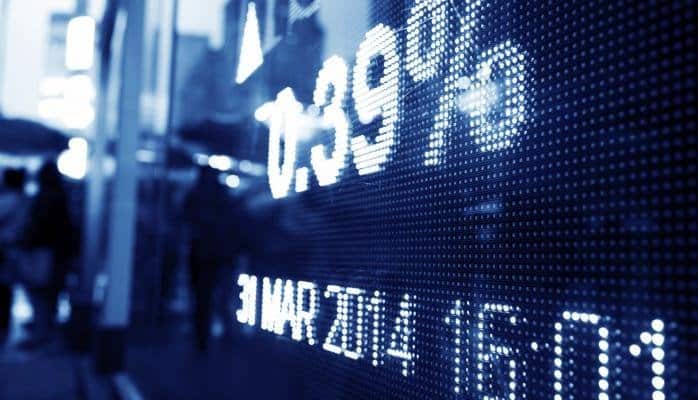Source: Electronic Trading and Order Matching System Basics
Electronic trading and order-matching systems are systems that facilitate the buying and selling of financial instruments, such as stocks, bonds, and currencies, by matching orders from buyers and sellers. Order Matching Systems are a subset of Electronic Trading Systems that are responsible for coordinating the purchasing and selling of financial instruments.
The algorithm of order matching system, which trade engine employs to match orders with available inventory on the market is known as the Stock Matcher. The software that facilitates the order-matching process is called the Trade Engine.
Trading in financial markets is now conducted in a manner that is both more efficient and more open, thanks to the existence of electronic trading systems. They include cheaper costs, shortened execution times, and increased levels of convenience compared to more conventional trading methods,
Order Matching Systems use algorithms, and the platform determines which algorithms are used. Time-price priority, pro-rata, and FIFO (first in, first out) are some of the more prevalent algorithms. These algorithms guarantee that orders will be matched in a manner that is both fair and effective.
What is Order Matching System?
An order matching system refers to the electronic process of matching buy & sell orders of a stock exchange or other similar financial exchanges. An order matching system is an electronic platform that automatically pairs buy and sell orders for securities based on criteria like price and quantity.
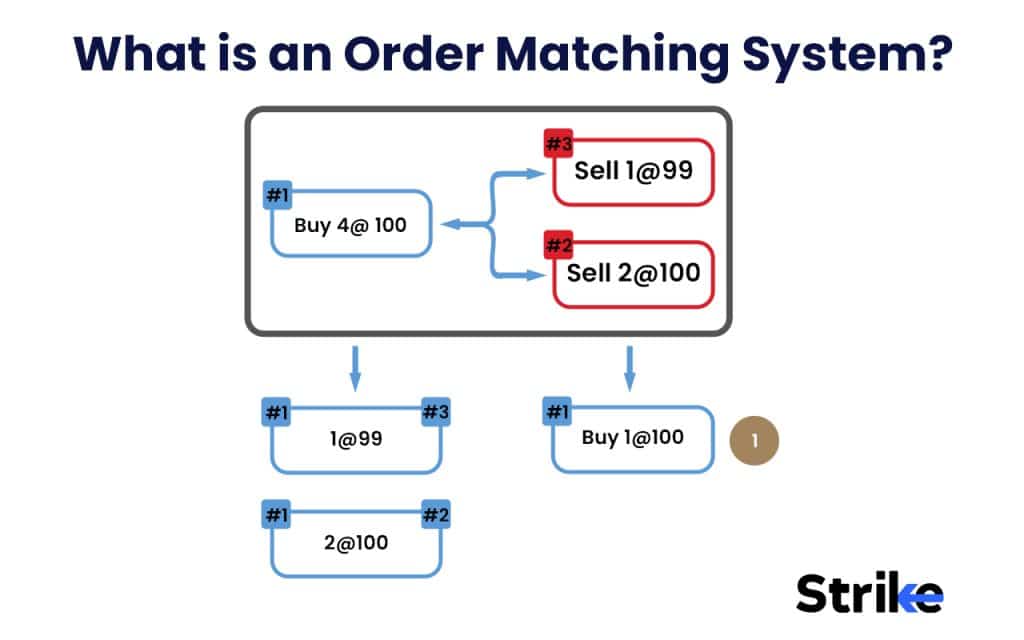
Order matching systems play a critical role in electronic trading by helping to Increase efficiency by automating the matching process and reducing the potential for human error. They Improve transparency and fairness by following predefined rules for order matching, allowing for faster execution of trades.
Order-matching systems improve transparency and fairness by adhering to preset order-matching criteria, allowing for speedier transaction execution. Order-matching systems possess several key characteristics. Limit orders, for example, enable parties to designate the price at which they are willing to buy or sell a financial instrument. Market orders, on the other hand, allow participants to execute trades instantly at the current market price. Furthermore, order priority rules are crucial as they set the sequence in which orders are executed, often dictated by the price and time of submission.
Electronic order matching system was first introduced in the United States in the early 1980s. It was introduced as a supplementary method to enhance the efficiency of open outcry trading systems. The then Mid-West Stock Exchange became one of the first stock exchanges to offer fully automated order execution in 1982.
Order Matching Systems make use of algorithms, the most common of which are a time-price priority, pro-rata, and FIFO. Pro-rata distributes the order among all traders who made orders at the same price, whereas time-price priority gives preference to the first order placed at a particular price. The FIFO, or first-in-first-out, matching method assigns items to orders in the order that they were received.
The Order Matching System supports the Electronic Trading System, which offers traders a platform from which they can electronically carry out deals. It enables a market that is both more efficient and transparent. The algorithms that Order Matching Systems utilise to guarantee that orders are matched fairly and efficiently contribute to the maintenance of market stability.
How Does Order Matching System Work in Electronic Trading System?
Order matching in an electronic trading system operates through eight vital steps. Within the stock market, this system diligently pairs buy and sell orders, primarily focusing on price and time priorities. These fundamental steps, ensuring a seamless trading experience, begin with order placement, followed by order routing, order queuing, price determination, order matching, trade confirmation, order reporting, and finally, the settlement. Each step plays a crucial role in maintaining the efficiency and transparency of electronic trading, contributing to its growing popularity in modern financial markets. The eight important steps are listed below.
1. Placing Orders. Traders and investors place buy or sell orders for a specific financial instrument, specifying the quantity and price limits. These orders are submitted electronically to the trading platform via computers or mobile devices.
2. Order Validation. The trading platform validates the orders to ensure they meet the required trading rules and regulations. This step helps maintain a fair and orderly trading environment.
3. Order Book. Validated orders are entered into the order book, a real-time record of all open buy and sell orders for a particular financial instrument. The order book displays the bid price, ask price, and quantity of orders at different price levels.
4. Order Matching. The system’s algorithm analyzes the order book and identifies compatible buy and sell orders based on price limits and order sizes. The trade is executed, and both parties are notified if a match is found,
5. Trade Execution. The trading platform updates the order book and executes the trade, transferring ownership of the financial instrument between the buyer and seller.
6. Trade Reporting. The details of completed trades, such as price, quantity, and time, are reported to the appropriate regulatory authorities and market participants. This information is used to track market activity and ensure transparency.
7. Trade Settlement. The settlement process begins after the trade is executed. This involves the transfer of funds between the buyer and seller and the transfer of the financial instrument’s ownership. Settlement typically occurs within a predetermined time frame, such as two days after the trade date (T+2).
8. Clearing. The clearing is the process of reconciling and confirming trade details, ensuring that all parties involved in the transaction have accurate records. This step is crucial for maintaining market stability and reducing the risk of errors or disputes.
The eight-step process of order matching, from order placement to trade settlement and clearing, ensures that trades are executed accurately and within a predetermined time frame. This process also helps reduce the potential for human error and ensures that all parties involved have accurate records.
What are the order matching rules for NSE?
The NSE uses a price-time priority algorithm to match buy and sell orders. Under this system, orders at the best price (highest bid or lowest offer) get first priority. The order that was entered first based on the timestamp gets matched first, following a first in, first out rule if multiple orders exist at the same price level.
After an order gets fully or partially executed, any remaining quantity goes back into the order book queue. Additionally, limit orders get preference over market orders at the same price point. Displayed orders are also given priority over hidden orders at the same price-time level. By following these and other rules that prioritize price discovery and liquidity provision, the NSE aims to ensure a fair and orderly market for order matching and execution.
What is Requests for a Quote (RFQ) in Electronic Trading Systems?
Requests for a Quote (RFQ) in Electronic Trading Systems refers to a process in which market participants, such as traders or investors, seek price quotations for a particular financial instrument from multiple liquidity providers. An RFQ is an essential component that helps traders and investors make informed decisions based on competitive pricing and other relevant factors in electronic trading systems.
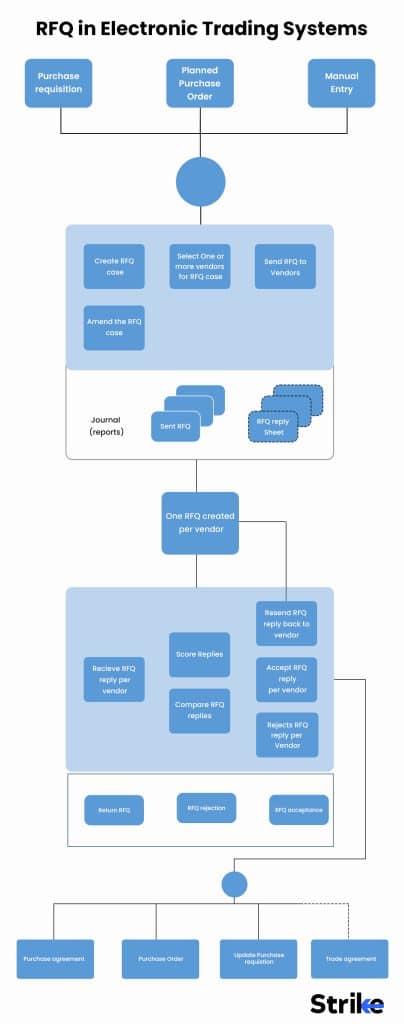
Below are the key components of an RFQ in Electronic Trading Systems.
Financial instrument. The specific asset for which the quote is being requested, such as stocks, bonds, options, or futures contracts.
Quantity. The number of units of the financial instrument being requested in the quote.
Side of the trade. Whether the market participants are looking to buy (bid) or sell (offer) the financial instrument.
Liquidity providers. The banks, brokers, or other financial institutions that supply the requested price quotations for the financial instrument. These providers compete for the trade by offering the most competitive quotes.
Price. The offered price for the financial instrument, expressed in terms of the currency or other relevant unit of measurement.
Spread. The difference between the highest bid and the lowest offer price provided by the liquidity providers. A narrower spread indicates a more competitive market.
Time limit. The duration within which the market participant must accept or reject the provided quotations. This helps to ensure that the quotes remain relevant and reflective of the current market conditions.
Order type. The specific type of order the market participant wishes to place, such as a market order, limit order, or stop order. Each order type has its own characteristics and implications for the execution of the trade.
Execution method. The manner in which the trade will be executed, such as electronically (algorithmic trading) or manually (voice trading). Different execution methods may result in different speeds, efficiency, and cost levels.
RFQ process enables traders and investors to make well-informed decisions when participating in electronic trading. Market participants can efficiently compare quotes, evaluate trading opportunities, and ultimately, enhance their trading strategies within the fast-paced environment of electronic trading systems by utilizing the RFQ process,
What is Electronic Trading System?
The electronic trading system (ETS) is a mechanism that enables seamless electronic trading of securities over the Internet. ETS is a computerized platform that allows traders to purchase and sell financial instruments electronically. Electronic trading systems have significantly streamlined the trading process, making it faster and more efficient. They reduce the time taken for order execution, allowing investors to capitalize on market opportunities quickly.
These systems provide real-time market information, ensuring investors can always access up-to-date data. This transparency helps in making informed investment decisions and promotes fair trading practices. Electronic trading systems help reduce the transaction costs associated with trading by eliminating the need for intermediaries such as brokers.
It is critical to understand ETS because it is the backbone of modern financial markets. It enables faster and more accurate trading and has made markets more accessible to a broader spectrum of participants.
The first ETS was developed in the 1960s, and the technology has since evolved. ETS has replaced Open Outcry, a classic trading style in which traders would physically assemble on a trading floor and shout out their orders.
Globex is a global electronic trading platform developed by the Chicago Mercantile Exchange in 1992. It gives you access to financial instruments, including futures and options contracts. Globex is open 24 hours a day, seven days a week, and allows traders to trade in marketplaces worldwide.
NASDAQ is another electronic trading platform that was established in 1971. It began as a platform for trading Over-The-Counter (OTC) equities but has now evolved to cover other financial instruments. NASDAQ is noted for its technology-focused enterprises and has become a symbol of the rise of the US tech industry.
What is the Backup System of the Electronic Trading System?
The backup system of an electronic trading system is a collection of technologies, processes, and policies that work together to ensure the continuity of trading operations in case of a system failure, technical glitch, or any unexpected downtime. This backup system is crucial to maintaining the trading environment’s integrity and stability.
The main components of the backup system include data backup and replication. It enables regular and real-time backups of all critical data, including trade information, order book data, and user accounts, taken to ensure that no data is lost during a system failure. Replication across multiple data centres also guarantees availability and redundancy. The system includes a Disaster recovery site. It is a separate, geographically diverse disaster recovery site maintained to provide continuous trading services in case of a failure at the primary location.
This site includes all necessary hardware, software, and network infrastructure to support trading operations. The system has automated failover mechanisms put in place to switch trading operations to the disaster recovery site or an alternative system if the primary system becomes unavailable due to a technical issue or another unforeseen event.
What are the fundamental features of Electronic Trading System?
The fundamental features of the Electronic Trading System include order management and Security.
The order Management system allows users to place, modify, and cancel orders efficiently. This helps in better management of orders in the financial markets. Below are the key features of the order management system.
Market Data. It provides real-time market data, including stock prices, trading volume, and other relevant information. These data are essential for making informed trading decisions.
Trade Execution. Electronic trading systems facilitate the quick execution of trades by matching buy and sell orders according to predefined rules, reducing the need for human intervention.
Automation. Algorithmic trading and other automated strategies can be easily integrated into the system, allowing traders to save time and minimize human errors.
Risk Management. The system offers various risk management tools, such as stop-loss orders, position limits, and margin requirements. These help traders in mitigating potential losses and manage risk effectively. Electronic Trading Systems employ robust security measures, including encryption and authentication protocols, to protect user data and prevent unauthorized access. Below are the key security features.
Compliance. The system ensures that all trades and activities comply with the relevant regulations and policies, reducing the possibility of legal and regulatory issues for traders and financial institutions.
Reporting. Traders can generate detailed reports of their trading activity, performance, and other relevant metrics. This helps in analyzing and improving trading strategies and decision-making processes.
Electronic Trading System has revolutionized the financial industry by offering a comprehensive, efficient, and secure trading platform, empowering traders and financial institutions worldwide to excel in their operations.
How is Electronic Trading System Data Protected?
Protecting electronic trading system is key as the trading systems are often a pillar of the economy. Protective measures are hence put in place to ensure the security and integrity of Electronic Trading data. Here are seven key aspects of data protection in electronic trading systems.
- Data transmitted between traders, brokers, and exchanges are secured using advanced algorithms so as to prevent sensitive information being intercepted or altered by any unapproved parties.
- Electronic trading systems employ stringent access control measures, including multi-factor authentication (MFA), to ensure only authorized users can gain entry.
- Trading systems are secured using cutting-edge firewalls and intrusion detection systems, which monitor for and block any unauthorized attempts at accessing the network, protecting it against potential security breaches.
- Sensitive data is stored on secure servers with robust encryption and regular backups to ensure its safety and retrieval in case of data breaches.
- Electronic trading systems must undergo periodic security audits in order to detect vulnerabilities and ensure all security measures remain up-to-date and effective.
- Systems comply with data privacy regulations such as the General Data Protection Regulation (GDPR) to ensure users’ personal data is safely stored and handled.
- Redundancy measures are in place to guard against system failures and data loss, ensuring electronic trading systems continue to function even in the event of hardware or software issues. These include backup servers and data centres as well as failover strategies.
- These systems are constantly monitored for any suspicious or unusual activities, with real-time alerts sent directly to administrators so they can investigate and address potential threats quickly.
The cyberspace in which the electronic trading systems fall in is continuously evolving and new challenges keeps coming up. It is hence important for the regulators to update the security systems on a timely basis as well.
How does Depository Trust Company Work as Recordkeeper of Electronic Stock Market?
The Depository Trust Company (DTC) plays a crucial role as a recordkeeper of the electronic stock market by executing the tasks like clearing and settlement, securities issuance and custody, etc.
Depository Trust Company also known as DTC provides a centralized clearing and settlement platform for securities transactions, ensuring the smooth transition of securities ownership and corresponding payments.It handles the issuance and custody of securities on behalf of issuers and shareholders, ensuring that securities are held safely in electronic form.
DTC also manages and processes corporate actions, such as stock splits, mergers, and dividend payments, updating the shareholder records accordingly. It facilitates securities lending and borrowing between its participants, helping to maintain market liquidity and allowing parties to meet their financial objectives.
DTC supports the shareholder voting process by distributing proxy materials, tracking responses, and tabulating votes on behalf of issuers and shareholders.It also assists with the reporting of taxes related to securities transactions, ensuring compliance with applicable laws and regulations.
DTC continuously monitors and manages risks associated with the settlement and clearing process, implementing measures to protect its participants and the broader financial system. And works closely with regulatory agencies to ensure its activities align with current regulations and industry best practices.
What Trading Records are Kept by Electronic Trading System?
Electronic trading systems maintain comprehensive trading records that provide transparency, efficiency, and security for market participants. These records typically include the following.
Order details. Information about each order placed, including the order type, price, quantity, time of order placement, and any modifications made to the orders.
Transaction data. Details of executed trades, such as the execution price, quantity, time of execution, and counterparty information.
Trade confirmations. Both the buyer and the seller receive trade confirmations after a trade, which specify the trade terms and conditions, including settlement instructions.
Order and trade history. Electronic trading systems store a historical log of all orders and trades, providing a valuable resource for analyzing trading performance, identifying potential inefficiencies, and ensuring regulatory compliance.
Market data. Real-time and historical market data, such as price levels, bid and ask spreads, trading volume, and other relevant information, is collected and disseminated by the system, enabling informed decision-making by market participants.
User profiles. Electronic trading systems maintain user-specific profiles, including trading permissions, access levels, and customized settings, ensuring a secure and personalized trading experience.
Risk management tools. Advanced risk management features are integrated into these systems, helping to monitor and manage financial risks, such as exposure, margin requirements, and position limits.
Compliance and reporting. Electronic trading systems facilitate regulatory compliance by automating the collection, reporting, and analysis of required data.
Dividends. Electronic trading systems often process and distribute dividends paid by companies to their shareholders. These systems track dividend payment dates, amounts, and eligibility criteria, ensuring accurate and timely dividend payments.
Clearing and settlement. Electronic trading systems often interface with clearing and settlement systems to streamline the process of completing trades, reducing the risk of errors and improving the market’s overall efficiency.
Liquidity provision. Electronic trading systems include features that facilitate liquidity provisions, such as algorithmic trading tools and market-making programs, helping to ensure smoother and more stable markets.
Electronic trading systems also provide connectivity to multiple exchanges, marketplaces, and other trading venues, enabling market participants to access a wide range of trading opportunities apart from the above.
What are the Risks of Electronic Trading Systems?
The main risks of Electronic Trading Systems are system failures. Below is a list of the main four risks, including system failures.
System Outages and Downtime. Electronic trading systems rely on complex technology, prone to outages, downtime, or other technical problems. Traders will not be able to access or execute trades during these disruptions.
Security Breaches and Hacking. Cybersecurity is a significant concern for electronic trading systems. Attacks by hackers can interrupt trading, compromise sensitive information, or manipulate data and transactions, potentially causing significant harm and financial losses.
Latency and Connectivity Issues. Delays in order execution due to latency or connectivity issues in fast-paced markets could result in missed opportunities or trades being executed at undesirable prices.
Algorithmic Trading Risks. Traders use algorithms to automate their trading strategies. Algorithmic trading comes with its own set of risks, including software bugs and glitches.
The occurrence of the above risks is minimized today due to the advent of technology. But traders should be aware of the same to ensure they are ready to tackle such a situation.
What is Flash Crash in Electronic Trading System?
A Flash Crash in Electronic Trading systems refers to an exceptionally rapid decline in the value of a financial instrument, typically within a few minutes or seconds, followed by a swift recovery. Sudden and sharp price movements usually characterize these events.
Flash crashes are marked by a dramatic price drop, often triggered by a single large trade or a series of trades executed quickly. The enormous trading volume during a flash crash often exacerbates the situation, making it difficult for market participants to execute orders at desired prices.
Flash crashes create a temporary imbalance in the supply and demand for a financial instrument, leading to a decrease in market liquidity and further magnifying price swings.
A flash crash occurs due to four main factors, including algorithmic trading. Algorithmic trading systems, which automatically execute orders based on pre-set rules, sometimes create a feedback loop that accelerates price declines. This occurs when multiple algorithms react simultaneously to similar market signals, creating a cascade effect. Flash crashes are sometimes triggered intentionally by malicious actors attempting to manipulate the market for their own gain. This involves placing large orders to create artificial price movements or exploiting weaknesses in trading algorithms.
Flash crashes result from technical issues within the electronic trading system, such as software bugs or hardware failures. These cause delays or errors in executing trades, leading to sudden price drops. Flash crashes are attributed to panic selling in some cases when a large number of investors rapidly sell their assets out of fear of further price declines. This sudden surge in selling pressure overwhelms the market, causing prices to plummet temporarily.
Flash crashes shake investor confidence in the stability and reliability of the financial markets. This results in reduced trading activity, lower market liquidity, and increased volatility in the short term. Flash crashes also prompt regulatory authorities to investigate the causes and implement stricter regulations on electronic trading systems, algorithmic trading, and market manipulation tactics. This leads to increased compliance costs for market participants and potentially limits the growth of algorithmic trading.
What are the Possible Technological Glitches in Electronic Trading Systems?
Technical glitches often posses the greatest threat to an electronic trading system. Below listed are four main technological glitches that happen.
Latency issues. Delays in data transmission, causing orders to be executed slower than intended.
Software bugs. Errors in the trading platform’s code lead to unintended consequences such as incorrect order placements or duplicate orders.
Hardware failures. Malfunctioning equipment such as servers, computers, or network devices, leads to downtime or lost data.
Security breaches. Unauthorized access to trading systems or data results in theft, data manipulation, or disruption of normal operations.
Overloaded systems. High volumes of trading activity cause the system to slow down or crash, affecting performance and reliability.
But the improvement in technology is able to sort out or minimize the occurrences of most technical glitches in electronic trading systems.
How to Invest in Stock via Electronic Trading Systems?
Electronic systems have made investing in stocks much easier than before. Below are the steps to follow to invest in stocks via electronic trading systems.
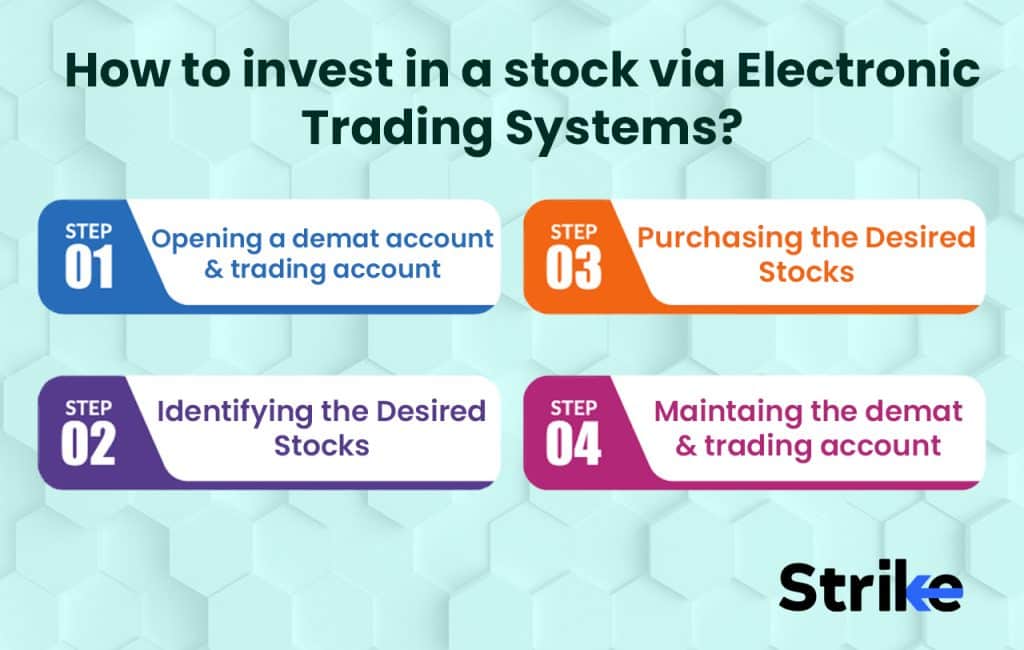
Trading Systems?
Choose a reliable electronic trading system. Research and compare various platforms to find one that suits your needs.
Open an account. Register and create a new account on the selected platform, providing personal information and linking a bank account.
Learn the basics of stock trading. Familiarize yourself with concepts such as buying and selling stocks, market orders, limit orders, and stop-loss orders.
Develop a strategy. Determine your investment goals and risk tolerance to create a tailored stock investment plan.
Research stocks. Analyze financial statements, company news, and industry trends to make informed investment decisions.
Monitor your investments. Regularly track the performance of your stocks, and stay updated on market news that may impact their value.
Set stop-loss orders. Protect your investments by setting stop-loss orders, which automatically sell stocks when they reach a certain price threshold.
Diversify your portfolio. Minimize risk by investing in a mix of stocks from various sectors and industries.
Re-evaluate your strategy. Periodically review your investment plan and adjust it based on your current financial situation and market outlook.
It is also important to stay informed about new investment strategies, tools, and market information to improve your stock trading skills continuously.
Which Matching Order Algorithms are used in Electronic Trading Systems?
The main matching order algorithms used in electronic trading systems mainly include First-In-First-Out (FIFO), and Pro-Rata.. Below are details about both of them.
1. FIFO Algorithm for Automated Electronic Trading System
The First-In-First-Out (FIFO) algorithm is widely used in automated electronic trading systems. FIFO works by matching buy and sell orders based on the order in which they were entered into the system. The algorithm is designed to provide fair and transparent execution of trades.
A chronological list of buy and sell orders awaiting execution. Orders are placed in the queue based on their timestamp. It matches with the earliest sell order available when a buy order enters the system. It matches with the earliest buy order available when a sell order enters the system. Trade execution occurs once the buy and sell orders are matched. The trade is executed at the agreed-upon price, and both parties are notified of the completed transaction.
2. Pro-Rata Algorithm for Automated Electronic Trading System
The pro-rata algorithm is a widely used matching method in electronic trading systems. It is designed to ensure fair allocation of orders among market participants. The algorithm allocates the available quantity of a financial instrument according to the proportional size of the participants’ orders in the book.
The pro-rata algorithm works by first Identifying the best bid and offer prices in the order book.
Then it determines the available quantity of the financial instrument at these price levels and calculates the total size of orders at the best bid and offer prices. It allocates the available quantity proportionally to the size of each order at these price levels, and orders with higher pro-rata allocation receive priority for execution.
It sometimes executes partial fills for orders, if necessary, based on their pro-rata allocation and updates the remaining quantity of the financial instrument in the order book The process is repeated until the order book is empty or no more matching opportunities exist.
What is Matching Principle in Matching Order System?
The Matching Principle in the Matching Order System is a fundamental concept in accounting that ensures expenses are reported in the same financial period as the revenues they generate. The matching principle aims to provide a more accurate representation of a company’s financial performance.
The matching principle works by recognizing expenses and revenues in the same accounting period. First, the company identifies the transactions that generate revenue during a specific accounting period. Next, the company matches the expenses incurred to generate those revenues. This can include direct costs, such as materials and labor, as well as indirect costs, like depreciation and overhead.
The company then records the expenses and revenues in the same accounting period to ensure they are properly matched. Finally, the company prepares its financial statements, taking into account the matched expenses and revenues, to provide an accurate representation of its financial performance during the specific accounting period.
Which Stock Markets do Use Electronic Trading?
Below are the five stock markets that use electronic trading and their origin.
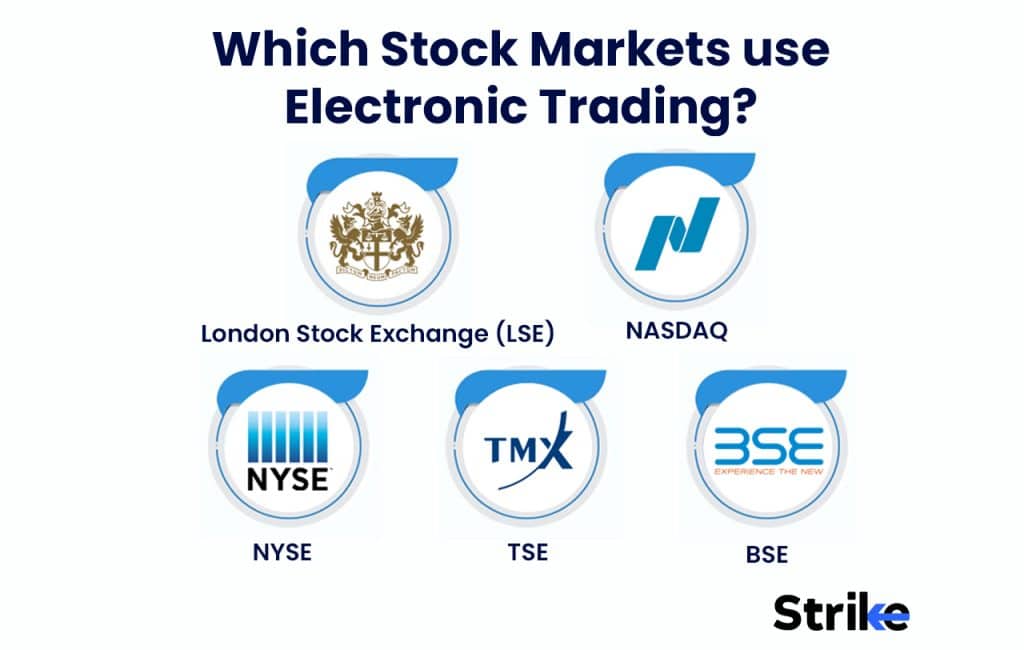
NASDAQ. Launched in the United States in 1971, NASDAQ was one of the first major stock exchanges to implement electronic trading from its inception, revolutionizing the way securities were bought and sold.
London Stock Exchange (LSE). Established in the United Kingdom in 1801, the LSE adopted electronic trading in 1997, enhancing market efficiency and providing a modernized platform for trading a wide range of financial instruments.
Tokyo Stock Exchange (TSE). Originating in Japan in 1878, the TSE transitioned to electronic trading in 1999, modernizing its operations and offering a more efficient, transparent, and accessible market for both domestic and international traders.
Euronext. Founded in the European Union in 2000, Euronext emerged as a result of a merger between the Amsterdam, Brussels, and Paris stock exchanges, leveraging electronic trading technology from the start to create a unified and efficient cross-border marketplace.
BSE (Bombay Stock Exchange). Established in India in 1875, the BSE adopted electronic trading in 1995, paving the way for more streamlined and transparent transactions in the rapidly growing Indian financial market.
All stock markets currently use electronic trading, and the above is just the top five list of stock exchanges.
Which Stock Markets Use Electronic Trading and Floor Trading together?
New York Stock Exchange (NYSE), London Metal Exchange and the Chicago Mercantile Exchange use electronic trading and floor trading together. Floor trading is still an essential component of both the price discovery process and the provision of liquidity although ETS is responsible for the vast majority of deals on the NYSE.
What is the History of Electronic Trading?
The National Association of Securities Dealers Automated Quotations (NASDAQ) became the world’s first electronic stock exchange when it opened for business in 1971. It was designed to make trading more streamlined and effective by automating the order execution process. The system enabled market players to engage in direct commerce with one another and connected them through the use of telecommunication lines.
The introduction of personal computers in the 1980s and the internet paved the way for the beginning of the widespread acceptance of electronic trading. It was now possible to execute trades without the assistance of a conventional broker due to the development of electronic communication networks, also known as ECNs. This resulted in higher levels of competition and lower costs associated with trading.
The introduction of algorithmic trading in the 1990s allowed dealers to use computer programmes to execute trades automatically based on established rules. This was made possible by the advent of algorithmic trading. This boosted the speed of trade while also reducing the amount of human intervention that was required.
Electronic trading emerged as the preeminent method of conducting business over the 2000s in most of the world’s financial markets. High-frequency trading, also known as HFT, is a relatively recent development in trading strategies. It is characterised by the use of algorithms to complete trades in a matter of milliseconds. Worries arose regarding the stability and fairness of the market because of this, and as a result, regulators started implementing new laws to address these issues.
What is the First Electronic Stock Exchange?
The first electronic stock exchange was NASDAQ, founded in 1971. NASDAQ was created to facilitate trading in over-the-counter stocks that were not listed on traditional exchanges like the New York Stock Exchange. NASDAQ used computers to match buyers and sellers, rather than relying on human brokers. This made trading faster and more efficient and paved the way for the widespread use of electronic trading in the financial industry.
Does Indian Stock Market use Electronic Trading System?
Yes, the Indian Stock Market uses an electronic trading system. The National Stock Exchange (NSE) and the Bombay Stock Exchange (BSE) are the two major stock exchanges in India that use electronic trading. The NSE was established in 1992 and became the first electronic stock exchange in India. The BSE, which was founded in 1875, introduced an electronic trading platform in 1995.
Why does High-frequency Trading prefer Electronic Systems?
High-frequency trading (HFT) prefers electronic systems mainly because of speed. Electronic systems enable HFT firms to execute trades at lightning-fast speeds. Advanced algorithms and high-speed computer networks allow these firms to analyze market data and make trading decisions in microseconds. Electronic systems also provide a highly efficient environment for trading. The automation of manual tasks and the ability to process large volumes of data in real-time significantly reduce errors and improve overall efficiency.
Trading on electronic platforms reduces the overhead costs associated with traditional trading methods, such as human brokers, increasing profit margins for HFT firms. Electronic systems also offer high transparency, as all market participants can access the same information. This level playing field promotes fair competition and reduces the chances of market manipulation.
What is the task of U.S Commodity Futures Trading Commission for Electronic Trading ?
The U.S. Commodity Futures Trading Commission (CFTC) has main responsibilities related to electronic trading. One of its main tasks is to regulate electronic trading platforms in order to ensure that they are fair and transparent. The CFTC also prevents fraudulent activities such as market manipulation and insider trading. The CFTC monitors electronic trading to identify potential risks to market stability and takes action to prevent or mitigate these risks.
How does Electronic Trading System affect Human Judgement?
Electronic trading platforms have the potential to lessen the influence of bias on decision-making and enhance the quality of decisions. Electronic trading systems can assist in lessening the impact of psychological biases such as fear, greed, and overconfidence by removing the emotional component of trading decisions.
This is accomplished by removing the emotional component of trading. But the effectiveness of electronic trading systems in reducing bias and improving decision-making depends on the quality of the algorithms and the underlying data used to generate trading signals. This is because electronic trading systems generate signals much quicker than traditional trading methods.


